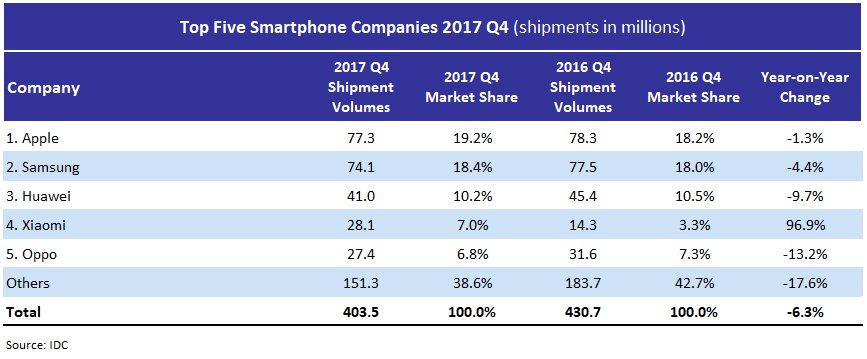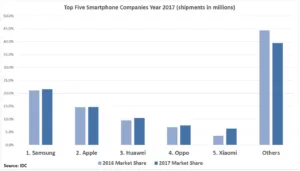A slower-than-expected 2017 holiday quarter closed out the year bringing minimal change to the worldwide smartphone market when compared to 2016. According to preliminary data from IDC, smartphone vendors shipped a total of 403.5 million units during the fourth quarter of 2017, resulting in a 6.3% decline when compared to the 430.7 million units shipped in the final quarter of 2016. For the full year, the worldwide smartphone market saw a total of 1.472 billion units shipped, declining less than 1% from the 1.473 billion units shipped in 2016. Developed markets such as China and the United States both witnessed a decline during the quarter as consumers appeared to be in no rush to upgrade to the newest generation of higher-priced flagship devices. Anthony Scarsella, Research Manager, Mobile Phones at IDC:
“The latest flock of posh flagships may have had consumers hitting the pause button in the holiday quarter. With ultra-high-end flagships all the rage in 2017, many of these new bezel-less wonders proved to be more of a luxury than a necessity among upgraders. Even though we have seen new full-screen displays, advanced biometrics and improved artificial intelligence, the new higher price points could be outweighing the benefits of having the latest and greatest device in hand”.
Jitesh Ubrani, Senior Research Analyst with IDC’s Worldwide Mobile Device Trackers, also commented:
“In the presence of ultra-high-end flagships, the still high-priced flagships from the previous generation seemed far more palatable to consumers in 2017. Many high-profile companies offered their widest product portfolio ever in hopes of capturing a greater audience. Meanwhile, brands outside the top five struggled to maintain momentum as value brands such as Honor, Vivo, Xiaomi, and Oppo offered incredible competition at the low end, and brands like Apple, Samsung and Huawei maintained their stronghold on the high end”.
Apple experienced a slight downturn from the previous holiday quarter as iPhone volumes reached 77.3 million units, a year-on-year decline of 1.3%. Volumes were still enough to push Apple past Samsung and back into first place in the smartphone market, largely because of iPhone 8, iPhone 8 Plus and iPhone X. Apple continues to prove that having numerous models at various price points bodes well for bringing smartphone owners to iOS. Although demand for the new, higher-priced iPhone X may not have been as strong as many expected, the overall iPhone lineup appealed to a wider range of consumers in both emerging and developed markets. Apple finished second for the full year in 2017, shipping 215.8 million units, up 0.2% from the 215.4 million units shipped in 2016.
Samsung remained the overall leader in the worldwide smartphone market for 2017 despite losing out to Apple in the fourth quarter. The Korean giant shipped 74.1 million units in the fourth quarter of 2017, down 4.4% compared to the 77.5 million units from the previous year. Samsung finished the year with 317.3 million shipments, up 1.9% from the 311.4 million shipments in 2016. Despite the failure of the Note 7, combined with the endless collective pressure from Chinese players along with Apple, Samsung has managed to remain on top through thick and thin. The pending arrival of their next flagship, the Galaxy S9, may represent the brand’s best chance of winning over both new and current customers in 2018.
Huawei continues to hold the number three position, despite intensified competition from growing Chinese players such as Oppo and Vivo. Huawei shipped 41.0 million units, down 9.7% from the 45.4 million shipped in the fourth quarter of 2016. The 2017 results look much better for the Chinese giant, as the Honor brand helped pushed sales both inside and outside of China. Huawei shipped 153.1 million units, up 9.9% from the 139.3 million unit shipped in 2016. The Mate series and Honor sub-brand continued to drive crucial volume in numerous markets, while the Y series thrived at the low-end. Recent aspirations for breaking into the US market are on hold as both AT&T and Verizon recently cut ties to bring Huawei flagships to the US. Entering the US through an official carrier remains critical for Huawei if it wishes to eventually dethrone market leaders Apple and Samsung.
Xiaomi managed to double its share to 7% from 3.3% during the holiday quarter the previous year. This comes as no surprise, since the company has continued to focus on growth outside China, with India and Russia being two of its largest markets. The company has been expanding its number of Mi Stores and Mi Service Centers, with fast build-out coming in markets like Indonesia. It also appointed Lazada to be the official online store and partnered with Indosat to offer a telco bundling package, where consumers can get Xiaomi’s smartphone for free by purchasing a data package for a one-year period. In India, Xiaomi also launched Redmi Y-series in India and roped in Bollywood celebrity Katrina Kaif to endorse the selfie-centric smartphone series as its first product endorser. The Redmi 5A, which was launched at $78, saw more than a million devices being sold within a month. The brand continued to expand its retail presence by adding more preferred partners, launching new Mi stores and partnering with large-format retail stores.
Oppo dropped one place to the fifth position, as the company shipped 27.4 million smartphones while managing to maintain 12% growth for the full year, amounting to 111.8 million smartphones. Like Xiaomi, Oppo has also managed to move beyond the domestic Chinese market and gain a foothold in other Asian countries like India, Indonesia, and Vietnam. In Indonesia, it launched the new F5 series in the fourth quarter of 2017 and also announced its partnership with AOV, a MOBA game. It ran a “selfie campaign” tour in many big cities in Indonesia to promote the AI feature in its selfie camera. In India, it continued to invest in celebrity endorsements and events. However, it faced a slight decline as it made some changes to its channel strategy by being more selective about its retail partners.




